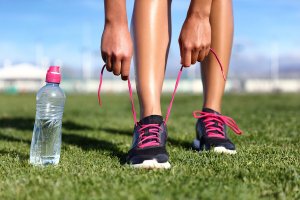Pros and Cons of Running on Different Surfaces

Running is great because you can do it anywhere and at any time. You also don’t need any additional equipment. However, not all terrains have the same benefits. Next up, we’ll talk about the pros and cons of running on different surfaces. Take notes!
Most runners simply put on their running shoes, go out the door and start running. However, it’s important to consider that some surfaces are better than others for some athletes.
Beyond this fact, it’s also true that choosing a running surface is as subjective as choosing a pair of shoes. Preferences vary from one runner to another.
Therefore, let’s go over the positive and negative aspects of running on different surfaces. As always, don’t forget to warm up, because this allows your body and muscles to relax and get the best performance while avoiding injuries at the same time.
Pros and cons of running on different surfaces
1. Treadmill
The treadmill allows you to train at any moment effectively, whether you do it at home or in a gym. As for this type of surface, it has the benefits of a race, which is why it may be an interesting alternative. However, it can’t replace other surfaces completely because of the biomechanical changes that it generates.
2. Running on different surfaces: synthetic track
Synthetic tracks consist of different superposed layers of polyurethane resin, rubber, and asphalt. That’s exactly why they represent the perfect compromise between the characteristics of rigidity and elasticity in comparison with other surfaces.
The negative side is that repetition when running several laps in a synthetic track can become boring and mentally hard for the athlete. In any case, synthetic tracks and asphalt are the best surfaces to work on your speed.

3. Asphalt
Asphalt is a rigid and stable surface, which facilitates a great performance in races and for speed. At the same time, asphalt also limits the number of strains or falls. For this reason, it’s one of the most used surfaces among runners when preparing for workouts and competitions.
However, asphalt has a major impact on the knees, ankles, back, hips and sometimes even the feet. This is why people who are overweight or have problems in their joints should opt for surfaces such as grass since it’s softer on their joints.
4. Running on different surfaces: grass
Grass is a soft surface that requires an additional energy expenditure. As a matter of fact, it causes the postural muscles to work harder to maintain the stability of the body in this space. Therefore, it’s the ideal surface to strengthen the muscles, especially the ones in your feet.
Running on grass allows you to gain strength and tone your lower body. In fact, it’s the best surface to avoid injuries.
5. Sand
Without a doubt, beach sand is an excellent surface to build muscle. This is because it promises the maximum efficiency, and it’s an environment that guarantees a plus for motivation. As you can imagine, the drier the sand is, the more your muscles will work.
Sand is a surface that allows you to work with a significant muscular intensity without forcing your joints. It works the muscles that are in charge of your balance, such as the stabilizing muscles in your ankles.
On top of this, if you’re looking for an activity that requires a greater effort, we recommend running with your legs slightly submerged in water. We’re sure you won’t regret this!

6. Running on different surfaces: mountain
The irregularity of the terrain makes it so that every step is different. This way, when you’re trying to avoid the obstacles, the movement is irregular. As a result, while the movement is less efficient, you’ve got a higher energy expenditure. In fact, most runners work harder on their intensity and endurance when they exercise in the middle of nature.
As you were able to see, runners can take advantage of the consequences of running on different surfaces. Besides making the right choice about this, it’s also important to choose a good pair of running shoes that guarantee all the cushioning that you need to avoid injuries.
Running is great because you can do it anywhere and at any time. You also don’t need any additional equipment. However, not all terrains have the same benefits. Next up, we’ll talk about the pros and cons of running on different surfaces. Take notes!
Most runners simply put on their running shoes, go out the door and start running. However, it’s important to consider that some surfaces are better than others for some athletes.
Beyond this fact, it’s also true that choosing a running surface is as subjective as choosing a pair of shoes. Preferences vary from one runner to another.
Therefore, let’s go over the positive and negative aspects of running on different surfaces. As always, don’t forget to warm up, because this allows your body and muscles to relax and get the best performance while avoiding injuries at the same time.
Pros and cons of running on different surfaces
1. Treadmill
The treadmill allows you to train at any moment effectively, whether you do it at home or in a gym. As for this type of surface, it has the benefits of a race, which is why it may be an interesting alternative. However, it can’t replace other surfaces completely because of the biomechanical changes that it generates.
2. Running on different surfaces: synthetic track
Synthetic tracks consist of different superposed layers of polyurethane resin, rubber, and asphalt. That’s exactly why they represent the perfect compromise between the characteristics of rigidity and elasticity in comparison with other surfaces.
The negative side is that repetition when running several laps in a synthetic track can become boring and mentally hard for the athlete. In any case, synthetic tracks and asphalt are the best surfaces to work on your speed.

3. Asphalt
Asphalt is a rigid and stable surface, which facilitates a great performance in races and for speed. At the same time, asphalt also limits the number of strains or falls. For this reason, it’s one of the most used surfaces among runners when preparing for workouts and competitions.
However, asphalt has a major impact on the knees, ankles, back, hips and sometimes even the feet. This is why people who are overweight or have problems in their joints should opt for surfaces such as grass since it’s softer on their joints.
4. Running on different surfaces: grass
Grass is a soft surface that requires an additional energy expenditure. As a matter of fact, it causes the postural muscles to work harder to maintain the stability of the body in this space. Therefore, it’s the ideal surface to strengthen the muscles, especially the ones in your feet.
Running on grass allows you to gain strength and tone your lower body. In fact, it’s the best surface to avoid injuries.
5. Sand
Without a doubt, beach sand is an excellent surface to build muscle. This is because it promises the maximum efficiency, and it’s an environment that guarantees a plus for motivation. As you can imagine, the drier the sand is, the more your muscles will work.
Sand is a surface that allows you to work with a significant muscular intensity without forcing your joints. It works the muscles that are in charge of your balance, such as the stabilizing muscles in your ankles.
On top of this, if you’re looking for an activity that requires a greater effort, we recommend running with your legs slightly submerged in water. We’re sure you won’t regret this!

6. Running on different surfaces: mountain
The irregularity of the terrain makes it so that every step is different. This way, when you’re trying to avoid the obstacles, the movement is irregular. As a result, while the movement is less efficient, you’ve got a higher energy expenditure. In fact, most runners work harder on their intensity and endurance when they exercise in the middle of nature.
As you were able to see, runners can take advantage of the consequences of running on different surfaces. Besides making the right choice about this, it’s also important to choose a good pair of running shoes that guarantee all the cushioning that you need to avoid injuries.
All cited sources were thoroughly reviewed by our team to ensure their quality, reliability, currency, and validity. The bibliography of this article was considered reliable and of academic or scientific accuracy.
- Ferris, D. P., Louie, M., & Farley, C. T. (1998). Running in the real world: Adjusting leg stiffness for different surfaces. Proceedings of the Royal Society B: Biological Sciences, 265(1400), 989–994. https://doi.org/10.1098/rspb.1998.0388
- McMahon, T. A., Biewener, A. A., Kerdok, A. E., Weyand, P. G., & Herr, H. M. (2015). Energetics and mechanics of human running on surfaces of different stiffnesses. Journal of Applied Physiology, 92(2), 469–478. https://doi.org/10.1152/japplphysiol.01164.2000
- Pinnington, H. C., & Dawson, B. (2001). The energy cost of running on grass compared to soft dry beach sand. Journal of Science and Medicine in Sport, 4(4), 416–430. https://doi.org/10.1016/S1440-2440(01)80051-7
This text is provided for informational purposes only and does not replace consultation with a professional. If in doubt, consult your specialist.








